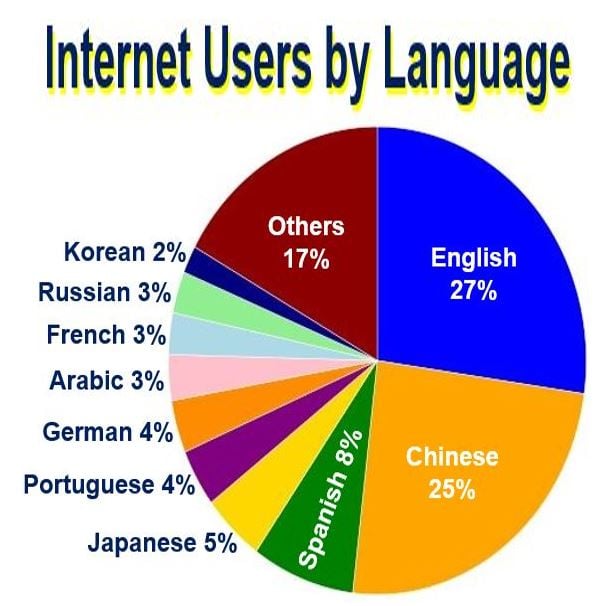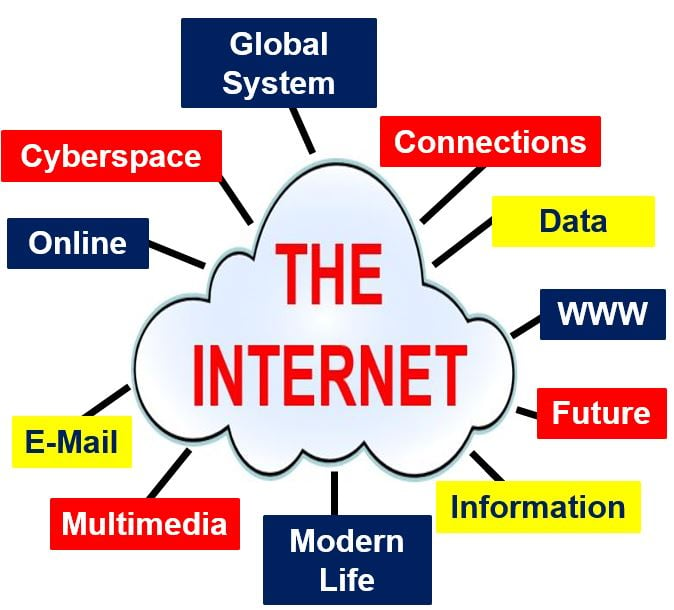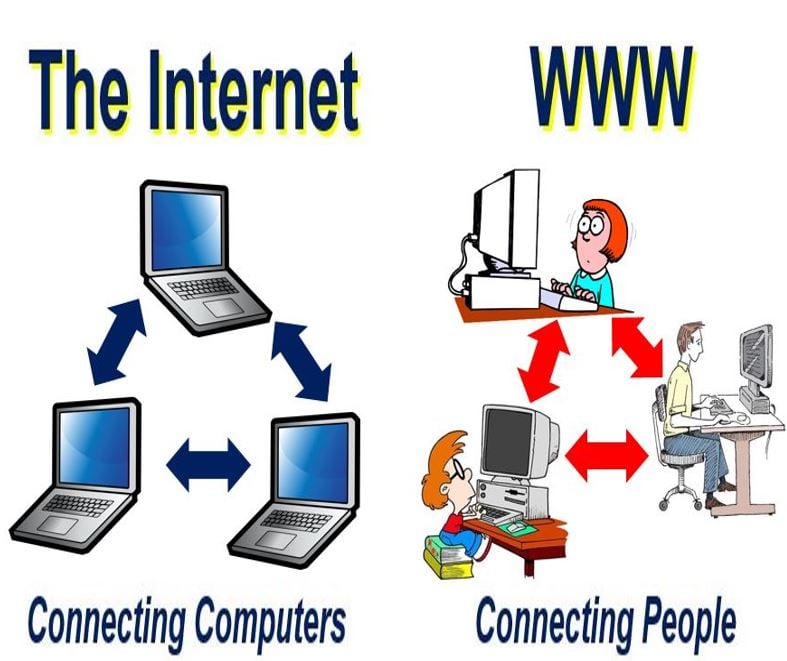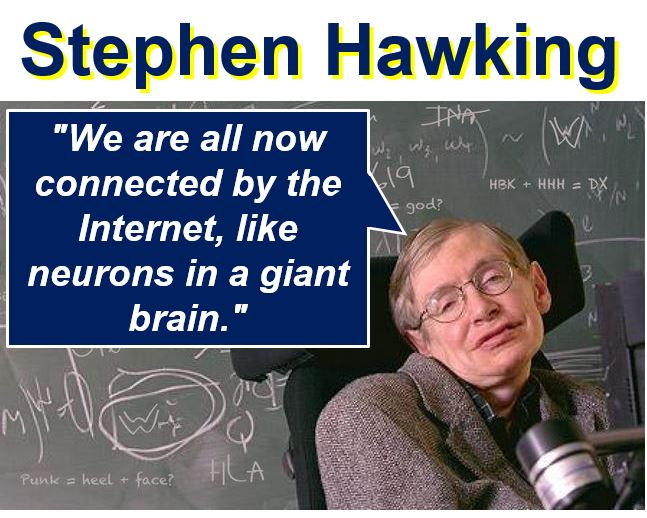The Internet, also known as the Net, is a worldwide network of computers interlinked in a similar way to the postal system, but at ultra-fast speeds. With the postal service, we send each other messages written on paper inside sealed envelopes, while with the Net, we send each other small packets of digital data from our computers.
For this light-speed postal service to work, we use a language called Transmission Control Protocol/Internet Protocol (TCP/IP). Any computer, smartphone, tablet, or other device that goes online must have an IP address.
In the Internet, dedicated routers and servers allow an electronic device to connect to any other devices globally.
When the two devices are connected over the net, they can receive and send several types of data including computer programs, text, video, voice, music, and graphics.
According to Internet Advisor.com, which has a database of Internet providers and their service plans:
“We are still in the early days of the Internet. Use is still growing rapidly in many parts of the world, and our reasons for going online are changing all the time.”

Internet – spelling
Initially, we always wrote the word with a capital ‘I,’ i.e., Internet. However, over the past few years, it has become increasingly more common to write the first letter in lower case.
The Internet does not belong to one individual, organization or country. However, a number of organizations across the world collaborate in its everyday functioning and development.
Each country’s telephone companies own the system’s ‘backbones,’ i.e., high-speed, fiber-optic cables. Most data travels through these cables.
How does the Internet work?
With the physical postal service, vehicles, trains, and airplanes carry your message. The message may subsequently go through a number of post offices along the way.
In the world of electronic communications, our messages – contained in packets of Net data – are transmitted through several cables, host computers, and routers until they reach their destination.

-
Data packages take different routes
Not all data packets take the same route – a feature that makes the net relatively resilient. If one of the components along the way fails, the system remains relatively intact.
When we use the post office, our message might contain one of several different kinds of data. A message may contain, for example, an invoice, legal documents, a birthday card, a love letter, photographs, etc.
We can send virtually anything through the net, including sound files, digital videos, letters, or invoices. We can also send computer programs.
Today the Web is used for a wide number of different applications, including file transfer, email, Usenet newsgroups, and Internet Relay Chat (e.g., WhatsApp texting).
This makes the Internet and the Web appear to be the same thing. However, these applications preceded the Web and are still able to run without it.
The Web vs. the Net
Many people think that the Internet and the World Wide Web are one and the same thing. This is not the case.
-
The Internet
The Internet is a huge network of networks. It is a networking infrastructure connecting billions of computers, smartphones, and other devices worldwide.
In this network, any connected computer can communicate with any other connected computer. Data that travels over the Net does so via a variety of protocols, i.e., languages.
-
The World Wide Web
We call it the World Wide Web, WWW, or simply the Web. It is a way of accessing data over the medium of the Internet.
In other words, the Web is a data-sharing model that is built on top of the Internet. Websites form part of the WWW.
Of the many languages we use over the Net to transmit data, the Web only uses the HTTP protocol. HTTP stands for Hypertext Transfer Protocol Secure.
HTTP-using Web services that use applications to communicate in order to exchange business logic, use the Web to share data.
The Web also uses web browsers to access websites. Firefox, Chrome, Explorer, and Safari, for example, are web browsers.
Websites contain documents, i.e., web pages, that link to each other via hyperlinks. These documents also contain texts, graphics, sounds, and video.
-
Email
The Web is just a portion of the Internet. Email, which relies on SMTP, FTP, instant messaging, and Usenet newsgroups, is part of the Internet but not the Web.

History of the Internet
The Internet did not have a single inventor, unlike technologies such as the telephone or light bulb. It evolved over time.
It gradually emerged in the 1960s in the United States as a government weapon during the Cold War.
For a long time, researchers used it to communicate and share information with one another. Today, we use the Net for so many things that it has become an integral part of our daily lives.
If you are less than thirty years old, you likely cannot imagine a society where nobody ever went online. However, it did exist.
-
The Net – a recent phenomenon
In fact, not being online was a normal state for 99.999% of human history. The Net is a very recent phenomenon.
About half-a-century ago, military experts and scientists worried about what might happen if there were an attack. Specifically, if the Soviet Union launched an attack on an allied country’s telephone system.
At the time, they said that one missile could destroy the whole network that made long-distance communication possible.
This would mean that heads of state would not be able to communicate with each other. How do you win a war if you cannot communicate with your allies?
In 1962, American psychologist and computer scientist, Joseph Carl Robnett Licklider (1915-1990), who worked at MIT and ARPA, proposed a ‘galactic network’ of computers that could communicate with one another as a solution to this problem.

According to Licklider, his proposed network would allow leaders of the US and its allies to communicate. They would even be able to communicate if a Soviet missile destroyed the telephone system.
-
Packet switching
In 1965, another scientist developed a way of sending data from one computer to another. He called it packet switching.
Packet switching involved breaking down the data into packets or blocks, before sending it to its destination. In that way, each packet could take its own route from sender to receiver.
Packet switching transformed the US government’s computer network – ARPAnet (Advanced Research Projects Agency Network). It became much less vulnerable than the telephone system to enemy attacks.
In 1969, just four computers – all of them at US universities – were on the ARPAnet. This grew to five thousand Internet hosts in 1986.
Each year the numbers grew rapidly until there were hundreds of millions.

-
The Internet expanded rapidly
In 1995, less than 1% of the world’s population had an Internet connection. From 1999 to 2013 the number of Internet users increased tenfold.
Today, an estimated 40% of the global population has an online connection.
The number of people with who could go online hit its first major milestone in 2005 – 1 billion. By 2010 there were two billion. In 2014, the total was three billion.
There are at this moment (May 26, 2018) 3,929,022,900 Net users in the world, according to internetlivestats.com. The total is growing rapidly every second of the day.
Online world today
Today, there are so many things people do online. Things that just a few decades ago we could not have imagined.
-
E-learning
E-learning, for example, has become very common. Millions of people across the world are currently studying an online course.
-
Online shopping
In some advanced economies today, online shopping is beginning to overtake traditional shopping.
-
Online banking
Thousands of retail bank branches globally are closing down every year due to online banking.
-
Remote Work
The COVID-19 pandemic accelerated the shift towards remote work, making it a new norm for many industries. This shift has had profound implications on work culture, technology use, and urban planning.
-
Communications and collaboration tools
Tools like Zoom, Microsoft Teams, and Slack have become integral to remote work and personal communication, transforming how people connect and collaborate.
-
Streaming services
The streaming wars have intensified with platforms like Disney+, Apple TV+, and others challenging established players like Netflix and Amazon Prime. This has changed how people consume media and impacted the film and television industries.
-
Artificial Intelligence (AI) and Machine Learning
AI has become more integrated into everyday life, influencing areas such as personalized recommendations, voice assistants (like Siri and Alexa), and even content creation.
-
5G technology
The rollout of 5G networks is enabling faster internet speeds and is expected to revolutionize various sectors including the Internet of Things (IoT), gaming, and augmented/virtual reality.
Demographics
-
In the year 2014
In 2014, almost 75% (2.1 billion) of all Internet users globally lived in the top 20 nations. The remaining 25% resided in the other 178 countries.
China, with 642 million users in 2014, represented almost 22% of the world total.
In the USA, UK, Canada, Japan and Western Europe, more than eighty-percent of the population has an online connection.
At the opposite end of the range, in India just 19% of the population can go online.
-
In the year 2023
The number of global internet users reached 5 billion as of July 2023, with Asia having the largest internet base of over 2.7 billion users.
Northern Europe boasts the highest internet penetration rate at 98%, followed by Western Europe at 94%, and Northern America at 93%. These high rates indicate a substantial growth in internet access in these regions. Conversely, internet penetration is still lower in regions like Southern Asia (46%), Western Africa (43%), Eastern Africa (26%), and Middle Africa (25%).
According to Oxford Dictionaries Language Matters, the Internet is:
“A global computer network providing a variety of information and communication facilities, consisting of interconnected networks using standardized communication protocols.”
With the emergence of the Internet and ad-blocking software, inbound marketing has become more and more popular. It involves using content – blogs, newsletters, podcasts, social media, etc. – that online users like, in order to lure them in.
Two Videos
These two educational YouTube videos come from our sister channel, Marketing Business Network or MBN. They explain what the terms “Internet” and “World Wide Web (WWW)” mean using easy-to-understand language and examples:
-
What is the Internet?
-
What is the World Wide Web (WWW)?
